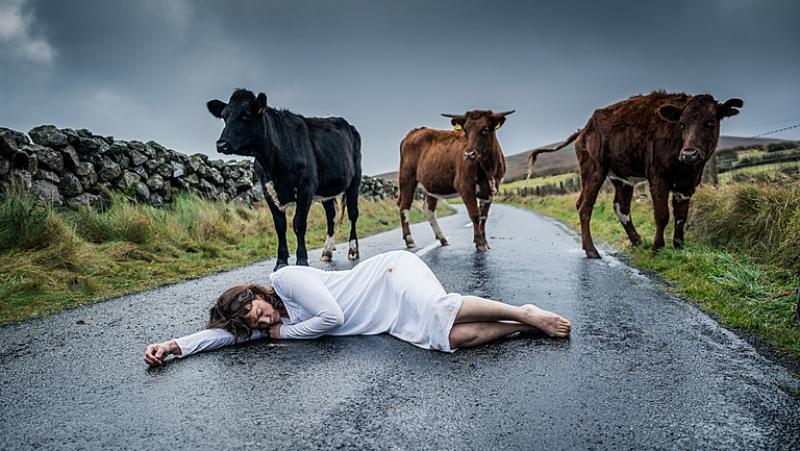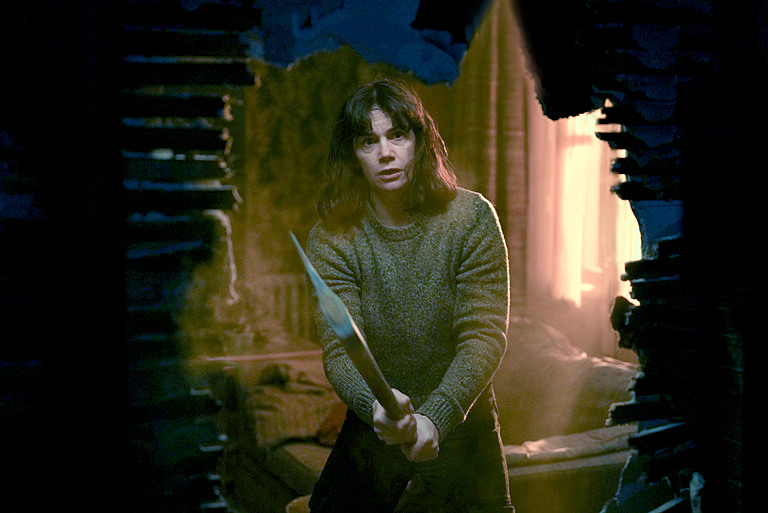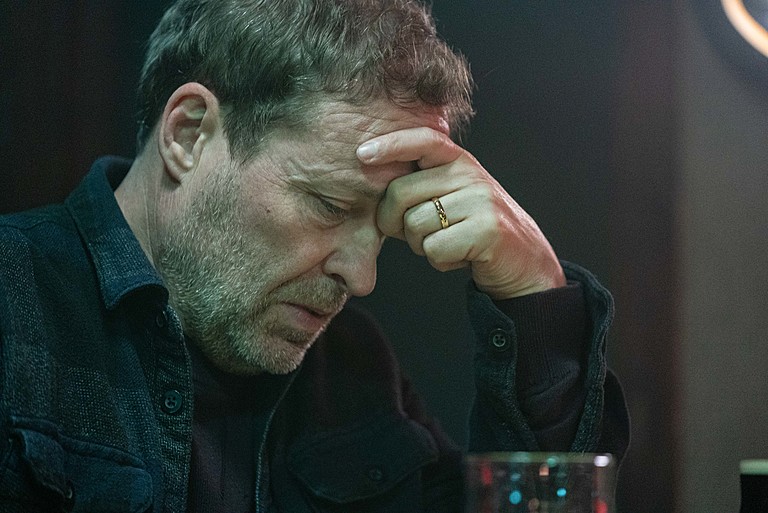The Woman in the Wall, BBC One review - deliciously dark murder mystery with a tragic hinterland | reviews, news & interviews
The Woman in the Wall, BBC One review - deliciously dark murder mystery with a tragic hinterland
The Woman in the Wall, BBC One review - deliciously dark murder mystery with a tragic hinterland
Ruth Wilson is a magnetic presence as a bedraggled victim of the Magdalene Laundries

Ruth Wilson possibly hasn’t had as much to get her teeth into on-screen since she vamped it up in Luther. Her performance as Lorna Brady in The Woman in the Wall is an object lesson in the way a performer in demand for her engaging looks and edgy sexiness can smartly step off that particular conveyor belt and go off in a totally new direction.
In Joe Murtagh’s script, she has found the ideal channel for both her experience and talent (she is an executive producer of the series too) and an important cause to champion. It’s 2015 in a small town in western Ireland, where bedraggled Lorna, a known sleepwalker, is regarded as “not right in the head” but basically harmless. We first encounter her after one of these episodes, asleep on a country road with an audience of cows. "I don't know what's real any more," she tells one of her few friends, a handy guide to the drama's MO. Lorna is deep-voiced, unkempt and furtive, yet driven by a wholly rational passion: to find out what happened to the baby removed from her when she was a teenager by the Sisters of the Seven Joys, in whose laundry she toiled. By day she now works as a seamstress; at night she is likely to be found alone in bars. On all sides, disorienting flashbacks keep invading her mind, soundtracked by crying babies and howling women. Then a note arrives to say the sender knows what happened to her daughter.
This would be an ample plot mechanism to power the whole series, but Murtagh throws in a second motor, the murder of a priest, which a Dublin detective arrives to investigate while battling secrets about his own upbringing. Why did he know this priest in his youth? Why is he also having flashbacks, of running down a grim tunnel in his long johns and seeing a figure lurching towards him?
 Lorna is not at first a suspect in the priest’s death. She has troubles of her own, having gone home from the bar to find a kitchen knife skewering the left eye of her portrait of Jesus. The knife was also embedded in a pipe in the wall behind the picture, which, when she removes it, springs a leak. Lorna dons overalls, hacks at the wall with an axe and uses welder’s tools to stop the flow. What a woman. The cavity she creates then turns into a useful hidey-hole a few days later for the corpse she comes home to find in her house, an older woman she vaguely recognises but has no recollection of killing.
Lorna is not at first a suspect in the priest’s death. She has troubles of her own, having gone home from the bar to find a kitchen knife skewering the left eye of her portrait of Jesus. The knife was also embedded in a pipe in the wall behind the picture, which, when she removes it, springs a leak. Lorna dons overalls, hacks at the wall with an axe and uses welder’s tools to stop the flow. What a woman. The cavity she creates then turns into a useful hidey-hole a few days later for the corpse she comes home to find in her house, an older woman she vaguely recognises but has no recollection of killing.
This near-grand guignol could have been projected as unsubtle violence for its own sake, but miraculously the plot points on the page aren’t the whole story. Wilson gives Lorna a wayward energy and sense of justice that make her a magnetic presence; she is oddly likeable, and also vulnerable. We want to know what happened to her to bring her so low, and duly find out as her flashbacks spell out a story of a community steeped in religious conservatism, where life-sized statues of the Virgin Mary greet you on the street and there's no place for unmarried mothers. Or rather, there is: “the convent”. Lorna’s mother had turned her back on her as her father condemned her to be moved there.
The tone and approach of The Woman in the Wall — essentially a repurposing of the Magdalene Laundries scandal as a ghostly thriller/noir comedy — don’t soften one bit the hideousness of what went on in these sadistic institutions for 200 years. This is not a meretricious drama feeding off a real tragedy but one that clearly wants to lure its audience in and help them register the horror of this backstory, which still isn’t adequately taught in Irish schools.
 The skill of the writing and direction (by Rachna Suri) is the light, almost comic touch it deploys on this dark material, a classic case of less is more. And never more so than in the scene where a group of mothers who had worked in the laundries for 16 hours a day while their babies were spirited away or allowed to die meet the head of an organisation (Dermot Crowley) formed to help them get justice for their ordeals.
The skill of the writing and direction (by Rachna Suri) is the light, almost comic touch it deploys on this dark material, a classic case of less is more. And never more so than in the scene where a group of mothers who had worked in the laundries for 16 hours a day while their babies were spirited away or allowed to die meet the head of an organisation (Dermot Crowley) formed to help them get justice for their ordeals.
The women have brought in items to talk about, one, Amy, producing a pair of nail clippers. Not the actual ones used by her persecutor, a nun who would cut Amy’s nails so short that they bled on her sheets, for which a separate nun would then punish her, but a prosaic but chilling memento mori. Another has brought the lying sheet of paper sent to her parents, detailing the results of all the exams she had never sat while toiling in the laundry. Lorna, typically, doesn’t sit with the others at first, an outsider even among fellow outcasts. But her memories crowd in, and we see she has her own culpability to face up to, regarding fellow launderer Clemence.
This is first-rate drama. The plot ducks and dives, and Wilson's hold on you grows with each episode. There's Frances Tomelty too, as the sugar-coated viper of a former Mother Superior, who spins the line that the laundries were “training centres”, to make the girls better mothers. And, a sign of the class of the series, Ardal O’Hanlon (pictured above) turns up as Dara, a violent man whose wife, a former nun, has disappeared. O’Hanlon’s transformation into an unrecognisably vicious-faced thug is nothing short of extraordinary.
The future of Arts Journalism
You can stop theartsdesk.com closing!
We urgently need financing to survive. Our fundraising drive has thus far raised £49,000 but we need to reach £100,000 or we will be forced to close. Please contribute here: https://gofund.me/c3f6033d
And if you can forward this information to anyone who might assist, we’d be grateful.

Subscribe to theartsdesk.com
Thank you for continuing to read our work on theartsdesk.com. For unlimited access to every article in its entirety, including our archive of more than 15,000 pieces, we're asking for £5 per month or £40 per year. We feel it's a very good deal, and hope you do too.
To take a subscription now simply click here.
And if you're looking for that extra gift for a friend or family member, why not treat them to a theartsdesk.com gift subscription?
more TV
 The Gold, Series 2, BBC One review - back on the trail of the Brink's-Mat bandits
Following the money to the Isle of Man, Spain and the Caribbean
The Gold, Series 2, BBC One review - back on the trail of the Brink's-Mat bandits
Following the money to the Isle of Man, Spain and the Caribbean
 Dept. Q, Netflix review - Danish crime thriller finds a new home in Edinburgh
Matthew Goode stars as antisocial detective Carl Morck
Dept. Q, Netflix review - Danish crime thriller finds a new home in Edinburgh
Matthew Goode stars as antisocial detective Carl Morck
 The Rise and Fall of Michelle Mone, BBC Two - boom and bust in the lingerie trade
Life in the fast lane with David Cameron's entrepreneurship tsar
The Rise and Fall of Michelle Mone, BBC Two - boom and bust in the lingerie trade
Life in the fast lane with David Cameron's entrepreneurship tsar
 Code of Silence, ITVX review - inventively presented reality of deaf people's experience
Rose Ayling-Ellis maps out her muffled world in a so-so heist caper
Code of Silence, ITVX review - inventively presented reality of deaf people's experience
Rose Ayling-Ellis maps out her muffled world in a so-so heist caper
 The Bombing of Pan Am 103, BBC One review - new dramatisation of the horrific Lockerbie terror attack
Six-part series focuses on the families and friends of the victims
The Bombing of Pan Am 103, BBC One review - new dramatisation of the horrific Lockerbie terror attack
Six-part series focuses on the families and friends of the victims
 theartsdesk Q&A: Zoë Telford on playing a stressed-out psychiatrist in ITV's 'Malpractice'
She nearly became a dancer, but now she's one of TV's most familiar faces
theartsdesk Q&A: Zoë Telford on playing a stressed-out psychiatrist in ITV's 'Malpractice'
She nearly became a dancer, but now she's one of TV's most familiar faces
 The Trunk, Netflix review - stylish, noir-ish Korean drama wrapped around a beguiling love story
Unusual psychological study of a stranger paid to save a toxic marriage
The Trunk, Netflix review - stylish, noir-ish Korean drama wrapped around a beguiling love story
Unusual psychological study of a stranger paid to save a toxic marriage
 Malpractice, ITV1, Series 2 review - fear and loathing in the psychiatric unit
Powerful return of Grace Ofori-Attah's scathing medical drama
Malpractice, ITV1, Series 2 review - fear and loathing in the psychiatric unit
Powerful return of Grace Ofori-Attah's scathing medical drama
 Fake, ITV1 review - be careful what you wish for
Australian drama probes the terrors of middle-aged matchmaking
Fake, ITV1 review - be careful what you wish for
Australian drama probes the terrors of middle-aged matchmaking
 Formula E: Driver, Prime Video review - inside the world's first zero-carbon sport
F1's electric baby brother get its own documentary series
Formula E: Driver, Prime Video review - inside the world's first zero-carbon sport
F1's electric baby brother get its own documentary series
 Flintoff, Disney+ review - tumultuous life and times of the great all-rounder
John Dower's documentary is gritty, gruelling and uplifting
Flintoff, Disney+ review - tumultuous life and times of the great all-rounder
John Dower's documentary is gritty, gruelling and uplifting
 Your Friends & Neighbors, Apple TV+ review - in every dream home a heartache
Jon Hamm finds his best role since 'Mad Men'
Your Friends & Neighbors, Apple TV+ review - in every dream home a heartache
Jon Hamm finds his best role since 'Mad Men'

Add comment